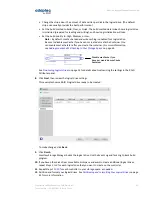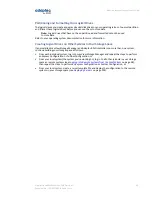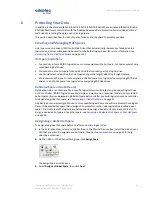
The Set Properties window opens.
3. In the Write Cache drop-down list, select
Enabled
,
Enabled when protected by battery/ZMM
,
or
Disabled
, as needed.
4. Click OK.
Changing the Stripe Size
The stripe size is the amount of data (in KB) written to one disk drive, before moving to the next disk
drive in the logical device. Stripe size options vary, depending on your controller and RAID level. For
example, in a RAID 6 or RAID 60 logical drive, the more disk drives included in the logical drive, the fewer
stripe size options are available. Normally, the default stripe size provides the best performance.
You can change the stripe size of an existing logical drive when you expand or migrate the logical drive.
For more information, see
Increasing the Capacity of a Logical Drive
on page 60 and
Changing the RAID
Level of a Logical Drive
on page 61.
Changing the Initialize Method
The initialize, or build, method determines how a logical drive is prepared for reading and writing and
how long initialization will take.
You can choose one of the initialization methods below when you create a new logical drive with the
Custom Configuration wizard. (The methods are presented in order of slowest to fastest.) You can change
the initialization method of an existing logical drive only when you expand the logical drive (see
Increasing
the Capacity of a Logical Drive
on page 60).
• Build—(slowest) For RAID 1 logical drives, data is copied from the primary drive to the mirror drive;
for RAID 5 logical drives, parity is computed and written. maxView Storage Manager performs Build
initializations in the background; you can use the logical drive immediately. Build is the default setting
for most logical drives
• Clear—Every block in the logical drive is overwritten with zeros, removing all existing data. You
cannot use the logical drive until the initialization is complete.
• Quick—(fastest) The logical drive is made available immediately. Quick is the default setting for RAID
1, RAID 1EE, and RAID 10 logical drives. It is recommended for use only with new drives.
• Skip Initialization—Reconstructs the logical drive meta-data without modifying or destroying other
data on the disks. Useful for recovering data when multiple drives fail in the same logical drive. For
more information, see
Multiple Disk Drive Failures in the Same Logical Drive
on page 112.
Optimizing Logical Drive Performance
To ensure optimal performance of the logical drives in your storage space, you can select an
application-specific performance mode to improve I/O throughput based on the needs of your application.
The following performance modes are supported by maxView Storage Manager.
Best Performance
Performance Criteria
Performance Mode
—
Automatically adjusts
criteria based on controller
Dynamic (default)
usage, RAID level, and disk
drive type
SAS:
100% Random
Online Transaction Process
(OLTP)/Database—a system
R0 Sequential writes (all request sizes)
60%--80% Read
that facilitates and manages
R0 File server and Web server
20%--40% Write
transaction-oriented
R5 Sequential writes (all request sizes)
8Kb Blocks
applications, such as data
entry or retrieval applications.
R5 Web server
R6 Web server
R10 Sequential writes
R10 Web server
SATA:
R0 Sequential reads (all request sizes)
57
Proprietary and Confidential to PMC-Sierra, Inc.
Document No.: CDP-00278-02-A Rev. A, Issue:
maxView Storage Manager User's Guide






























